The Famous Sheboygan Dead Horse Picture
The man, the myth, the legend…over a century later, the questions still linger: Who is the man in the picture, and what is he doing sitting on a dead horse in the middle of the intersection of Indiana and Griffith Aves. in Sheboygan, WI?
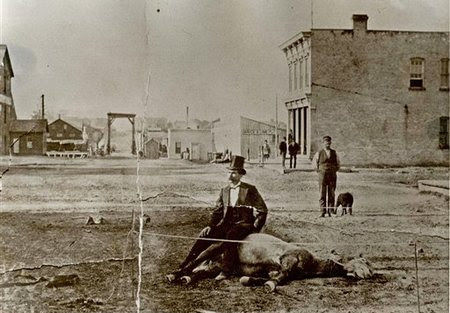
Those of you who have read The Dead Horse Investigation: Forensic Photo Analysis for Everyone, are aware that we were able to narrow down the date of the famous Sheboygan Dead Horse photo to five possibilities: May 5, 1867, 1872, or 1878, or August 10, 1873 and 1879. Through a fortuitous encounter with a member of the Saskatchewan Genealogical Society named Susan, we have been able to further narrow the date even further.
A short review for new Dead Horse afficianados…
The intersection of Griffith and Indiana Aves in Sheboygan is quite different now than it was in the late 1800s. Today there is a traffic circle located just north of where the man was seated on his dead horse.
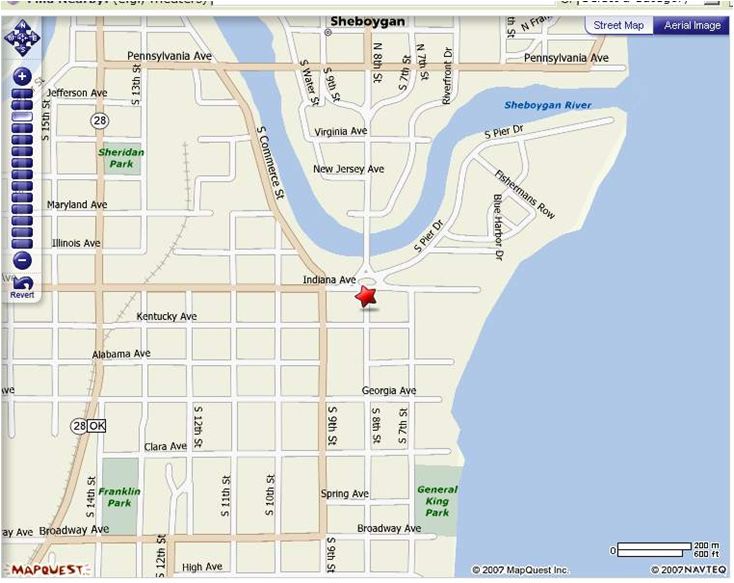
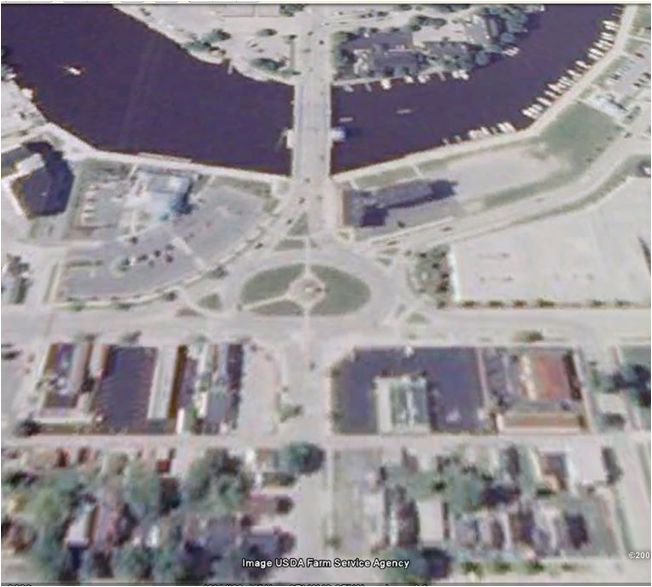

as seen on Google Maps, Google Earth, and Google Street View.

The area of Sheboygan pictured was the industrial area in town in those days. Not many records of the development of this area on the south side of the Sheboygan River survive. No earliest date can be obtained from building permits or construction records. City directories have also been of no use. They were not published every year, and where they do exist, the listings only reference intersections or streets, without mentioning specific addresses.
Fortunately, there are other clues that can be used to date the picture. The key to the earliest date the picture could have been taken comes from noticing that the photograph was taken with a wide angle lens. Only using such a lens could the photograph include over half the width of the street, 40 ft.
The wide angle lens was first produced in 1865 in by Emil Busch in Rathnow, Germany. Of course, it probably took some time for news of the lens to reach Sheboygan, and even more time for the photographer to obtain one. The true earliest date of the picture (the date the photographer received the lens) was probably much later than 1865, but we don’t have enough information to know when this happened. All we can say is that the picture must have been taken after the invention of the wide angle lens in 1865.
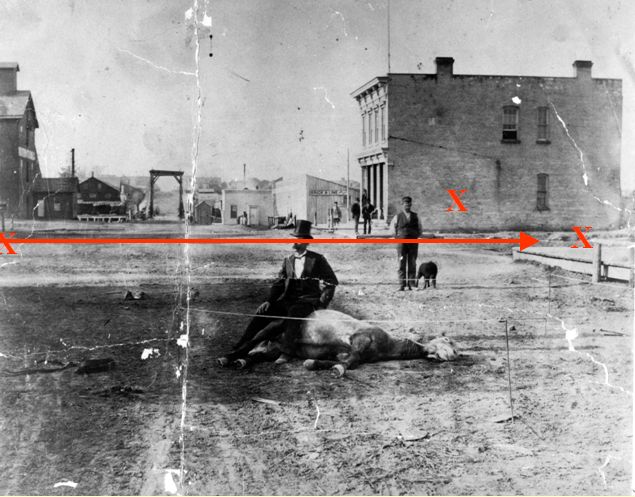
The latest date the photo could have been taken comes from comparing the shadows of the buildings to information given by the 1880 census. The census for that year tells us that there were three saloons occupying corners of the intersection. The northeast corner is occupied by the Evergreen Hotel, the Italianate building in the background to the right that was a hotel and saloon built long before the 1880s. The southeast corner across from it is empty.
Sheboygan was built on a grid with the streets running north-south and east-west. The photographer was looking to the north along what was then Griffith Ave, now known as 8th Ave. When a line is drawn from the empty southeast corner directly across the street to the southwest corner, it does not pass through the shadow falling on the man. That shadow is being cast by the building that is on the second lot from the corner. We can’t see what was on the southwest corner, but we can conclude that it was empty.
Since there were at least two empty corners at the time the photograph was taken, it must have been produced before 1880.
The picture was taken between 1865 and 1880.

The time of day can be derived by using the man as a sundial. Measuring the length of the shadow he cast would normally be difficult without a correction for the perspective of the camera. That is, lengths as viewed by the camera will appear shortened by the sine of the angle of the line-of-sight of the camera with respect to the length being measured. There would also be a correction for the effects of the wide angle lens, which can also distort lengths.
However as luck has it, the shadows in the picture run directly across the street, so that the sun is exactly in the west (270 degrees azimuth). With the camera facing north-south, the corrections for perspective are much easier. Actually, if we assume that the photographer was far away from the man and the horse relative to the width of the street, we can neglect the effects of perspective all together. This was probably true, although it might not seem like it because of the way the wide angle lens distorts distances.
To determine the time of day, you also need the height of the sun over the horizon, called its elevation. This can be determined by using a little bit of high school trig. The line from the top of the man’s hat to the tip of its shadow on the street is the hypotenuse of a triangle. The line from the same point on the hat to the ground is the side of the triangle opposite the angle we wish to know. The sine of the angle is the length of the opposite side divided by the length of the hypotenuse. Taking the arcsine gives us an angle of 15.7 degrees.
You finally need the coordinates of the man and his horse. According to Google Earth, the man was located about 43 deg 44′ 35″ N latitude, 87 deg 42′ 47″ W longitude.
An ephemeris will tell you that the sun is at 270 degrees azimuth and 15.7 degrees elevation at this location in Sheboygan every year on May 5 and August 10 at 4:52 pm.
To recap, the picture was taken on May 5 or August 10, between 1865 and 1880 at 4:52 pm.
Although the Sheboygan neighborhood shown in the picture was an industrial area, the streets are almost deserted. To help us narrow down the date even further, we guessed that the picture was taken on a Sunday; otherwise we believe that the street would have been more crowded, if not with people, then with wagons and other horses.
Using the perpetual calendar at www.wiskit.com, the only instances when May 5 or August 10 fell on a Sunday were May 5, 1867, 1872, and 1878, or August 10, 1873 and 1879.
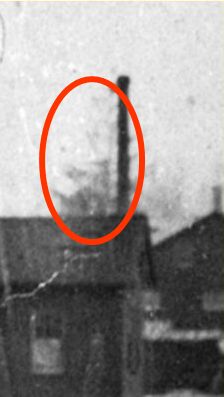
In the Dead Horse Investigation, we left it at that. However, during my recent conference in September 2010 in Yorkton, Saskatchewan, a member of the Saskatchewan Genealogical Society named Susan noticed a clue that even the top Dead Horse experts in the world had missed – the leaves on the trees behind the A-frame building in the background to the left.
Because I come from a warm climate, it did not occur to me that the trees in Sheboygan would still be without leaves as late in the year as May. Since the tree looks like it is in full foliage, the picture must have been taken on either August 10, 1873, or August 10, 1879.
If anyone has any ideas on why the scene favors either one of these dates, please contact me immediately. In the meantime, buy the book, don’t wait for the movie!
For more information on how you can purchase your very own copy of The Dead Horse Investigation, visit our order desk at www.forensicgenealogy.info/services.html.
November 26, 2010

15 Responses
Hi there,
I really enjoyed reading this article. I stumbled across this site quite on accident through Google Images. I am a horse lover and owner, located in Michigan.
I don’t believe the horse is dead. When I viewed the full size image I noticed a few things that helped me come to this conclusion.
1) The face of the man sitting on top of the horse is blurred. He must have been moving ever so slightly as the photograph was being taken. All other living things in the picture, including the horse also have blurred heads.
2) There are fresh marks in the dirt near the horse’s hooves and head. One very prominent streak near it’s front-end. This horse was moving not too long before this picture was taken.
3) The horse looks like it was blinking. If it was dead (unless killed a short while before this photograph was taken) wouldn’t it’s eyes be open? Wouldn’t the animal be bloated with gas? I believe the appendages would appear more stiff, and stuck-out at straighter angles. Legs straight out underneath the animal. But the horse looks as though it is resting, just having laid down.
4) I think this horse was trained to lay down on command. I’m currently teaching my gelding to do the same trick. Usually the handler would need a halter & leadrope or bridle & reins to control the animal during this maneuver. Although the horse’s muzzle is over-exposed, I can see a line of what appears to be a rein or leadrope running from near the horse’s mouth towards the back of the neck (the withers). I can also see what appears to be a noseband, furthering my belief this horse has either a halter or bridle on.
That would be a great reason for posing for a photograph, wouldn’t it? Your horse laying down on command? This equestrian might be showing off his horsemanship and training skills with this trick.
5) I think the horse’s ear is of great importance. You’ll notice the black blurry triangle just above the horse’s eye. This ear was moving during white the shutter was open. While working with horses whether riding or in-hand, a handler must pay great attention to their ears. They can move each ear independently of the other in many different directions. If their ear is cocked towards you, it’s their way of saying “hello, okay, I’m listening to you.” While riding, training, lunging, or doing tricks – a horse’s ears are usually always on the move.
6) This kind of goes with #3. The horse appears to be in good health. It’s not underweight, and has no obvious physical damage, broken legs, scarring or blood. The horse is well shod (all hooves are proper length with horseshoes), and she maybe even a little fat. I think this horse is an adult mare, probably five to fifteen years old, dappled gray in color. I suppose an explanation for her untimely death could be dehydration and/or colic – which would be why we can’t see anything obvious that attributed to her death. Perhaps it was a long, hard day at work.
7) The man is clearly relaxed on top of the horse. Maybe they’ve done this trick hundreds if not thousands of times. Maybe that explains his fancy suit and hat. This might be their job, a man and horse, traveling about and performing their tricks. At first I thought his left hand was in his pocket, but you can see his knuckles. Assuming he is not grabbing his buttocks, I think his hand might be on the rein or leadrope, in control of the horse.
8) The fence around the horse baffled me at first. My first thought was “Oh, this horse is dead. They put up a barrier to keep people away from the dead animal.” But then I realized that it might be temporary fencing. If I haul my horse to a trail ride or horse show I’ll usually have some sort of enclosure, so my horse doesn’t have to be tied up to the trailer all day and night. This could be an expensive metal fence/gate system or something as inexpensive as t-posts and a line of wire running along the topmost rung (which looks remarkably like the sticks and wire/string used here). The left-hand side of this fence appears to have some line dangling. This could be the makeshift gate. This type of temporary holding pen works well for a fence-trained horse.
I think I covered everything that I noticed about the picture. I might be wrong, maybe this horse is really dead. Alas, those are my observations. I hope to learn the truth of this photograph someday! Happy Holidays! ~Holli
Hi Holli,
Merry Christmas. Thanks for the observations. I really enjoyed reading them and plan to go over them very carefully.
Colleen
I love your blog, I’m from India and am very much interested in the Benjaman case! 🙂
Thanks! I’ve been really busy, but plan to start writing new articles this month. Benjaman is quite a mystery.
Colleen
Hey Holli! I have a counter-question to your 1st point- This photo was clicked in the 19th Century and the blur must have been because of the bad quality of the image that it was found in. Think about it and let me know your views on this. Let me tell you, I strongly agree with #7
Greetings Nishant!
Very good point. I have now given it more thought but I’m still thinking that this horse was alive and performing a stunt with it’s handler.
A closer examination of all the blurry elements in the photo lead me to believe this horse is alive.
Objects such as the large building to the right and wooden structure to the left aren’t of the best quality and detail – however their details are relatively crisp compared to the live subjects in the image. Also note the “crispness” of the ground on which the horse and handler lay. By studying the blurriness/fuzziness around each human, canine and equine it seems to suggests movement:
• The people in the background are very fuzzy, perhaps walking in/out of that building or moving closer to the street to get a better look at this horse and handler.
• The gentleman with the dog seems to be standing as still as he can (even slightly posed), knowing that he’s going to be in this photograph. His dog, while obedient and planting his feet, can’t seem to keep his head still and seems to be looking around at all the excitement. It looks as though he may have been wagging his tail (his back and bottom are slightly blurred, too).
• The horse and handler: While the shutter was open it looks as though the horse and handler both moved their heads. The horse’s head has a blurriness to it that makes me think it moved it’s head up and over slightly/then back down to the ground to get a better look at the human on it’s belly. The human has a horizontal motion blur (maybe he quickly snapped his head towards the horse when he noticed the horse beginning to move during the taking of the photograph).
One thing I forgot to mention last time was this clothing worn by the man on top of the horse. He looks rather well dressed compared to the others in the photograph. Maybe this is his performance apparel? I also just realized his boots seem to have a pointed toe, perfect for riding and training horses.
I’m having fun guessing as to what is going on in this photo, but it sure would be something to know the truth!
Best regards,
Holli
The one thing I noticed about this is the shadows. I think the shadow used for calculating the suns angle was not from the man, but from a pole on the building. Look at how much shorter the shadow is of the man standing in the background compared to the length of the shadow assumed to be of the man on the horse.
It appears to me, just from first glace, that the suns angle is closer to 45 based on the man standing, not 15 as calculated from the shadow beside the man on the horse. Just my observation….
…never mind, the shadow I referred to is from the dog, not the man. I believe you are correct…
Hi Quad,
We worked from a very high resolution version of the photo when we calculated the shadows. In this high res version, the shadows of the posts are clearly visible, as is the shadow of the man. We were careful in drawing the line we used to calculate the elevation of the sun, making sure it grazed the man’s hat at the point where the sun rays grazed it, ending at the corresponding point on the hat’s shadow on the ground. In the high res version you can see an indication of the shadow of the brim of the hat.
Using the high resolution version of the image, we did the best we could, considering the limit to the detail we could resolve and the uneven texture of the road, also taking into account the tears in the picture.
Colleen Fitzpatrick
Hi,
This is a really interesting thread. I found myself initially dismissing what Holli was postulating as wishful thinking but when you think things through it does make a lot of sense.
A travelling showman performing his daring feats on a quiet day of the week when crowds could gather in the centre of town unhindered by the usual hustle and bustle from the Monday to Saturday traffic. Here’s a link to a video that demonstrates Holli’s conclusion rather well https://www.youtube.com/watch?v=OLtcWXvDGj8 .
So now I guess the hunt will be on to find supporting evidence in the form of ‘sister’ images taken in the same area. Potentially, if we are looking at a ‘Showman and his horse’ type scenario then presumably he offered to pose for local photographers for a small fee and so there’s potential for other images to be out there showing the same scene in different towns or villages.
Fascinating stuff!
Regards,
John
Email should read: jheavyside@ntlworld.com and not as stated in my post.
Has anyone researched local newspapers (if they exist) from the period? If there was a traveling showman (and horse) or if there was some sort of accident with the horse (I see a leather strap and other odds and end laying in the road), the local newspaper surely would have mentioned it.
Hi Sally,
Great suggestion. When we first analyzed the photo, we scoured the newspapers for any article that might provide some kind of insight into the situation. That was maybe ten years ago. I believe we spoke about possible newspaper articles with the Sheboygan Historical Research Center but all of us came up empty-handed.. There are a lot more newspapers online now, so maybe we should revisit this. I think the chances are slim that we will find anything, but who knows?
Colleen